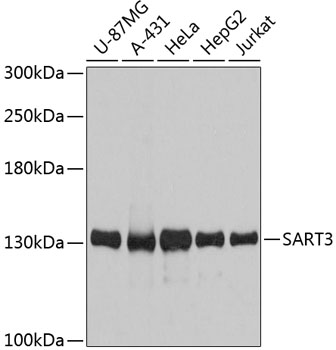-
Product Name
SART3 Polyclonal Antibody
- Documents
-
Description
Polyclonal antibody to SART3
-
Tested applications
WB
-
Species reactivity
Human
-
Alternative names
SART3 antibody; DSAP1 antibody; P100 antibody; RP11-13G14 antibody; TIP110 antibody; p110 antibody; p110(nrb) antibody; squamous cell carcinoma antigen recognized by T-cells 3 antibody
-
Isotype
Rabbit IgG
-
Preparation
Antigen: Recombinant fusion protein containing a sequence corresponding to amino acids 664-963 of human SART3 (NP_055521.1).
-
Clonality
Polyclonal
-
Formulation
PBS with 0.02% sodium azide, 50% glycerol, pH7.3.
-
Storage instructions
Store at -20℃. Avoid freeze / thaw cycles.
-
Applications
WB 1:500 - 1:2000
-
Validations

Western blot - SART3 Polyclonal Antibody
Western blot analysis of extracts of various cell lines, using SART3 antibody at 1:3000 dilution.Secondary antibody: HRP Goat Anti-Rabbit IgG (H+L) at 1:10000 dilution.Lysates/proteins: 25ug per lane.Blocking buffer: 3% nonfat dry milk in TBST.Detection: ECL Basic Kit .Exposure time: 30s.
-
Background
U6 snRNP-binding protein that functions as a recycling factor of the splicing machinery. Promotes the initial reassembly of U4 and U6 snRNPs following their ejection from the spliceosome during its maturation. Also binds U6atac snRNPs and may function as a recycling factor for U4atac/U6atac spliceosomal snRNP, an initial step in the assembly of U12-type spliceosomal complex. The U12-type spliceosomal complex plays a role in the splicing of introns with non-canonical splice sites. May also function as a substrate-targeting factor for deubiquitinases like USP4 and USP15. Recruits USP4 to ubiquitinated PRPF3 within the U4/U5/U6 tri-snRNP complex, promoting PRPF3 deubiquitination and thereby regulating the spliceosome U4/U5/U6 tri-snRNP spliceosomal complex disassembly. May also recruit the deubiquitinase USP15 to histone H2B and mediate histone deubiquitination, thereby regulating gene expression and/or DNA repair. May play a role in hematopoiesis probably through transcription regulation of specific genes including MYC (By similarity).; Regulates Tat transactivation activity through direct interaction. May be a cellular factor for HIV-1 gene expression and viral replication.
Related Products / Services
Please note: All products are "FOR RESEARCH USE ONLY AND ARE NOT INTENDED FOR DIAGNOSTIC OR THERAPEUTIC USE"
